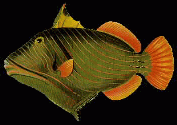
Lectures: Tuesday and Thursday from 11:30AM-1PM, 1024 DANA
In the lectures, we will be covering many aspects of the evolutionary biology of the craniates commonly known as fishes. There will be an introductory series of lectures placing fishes in the context of craniates as a whole, and giving you some feeling for fish taxic and morphological diversity. The following lectures will place special emphasis on life in the aquatic medium, including renal physiology, aquatic respiration, osmotic balance and suction feeding. In addition, we will be examining the reproductive biology, ecology, and behavior of fishes. The theory and practice of comparative biology and biogeography will also be examined. The class format will be lecture and informal discussion.
Students will do an independent study of some topic in fish biology during the term, and will be expected to make an oral presentation to the class on the results. The format will be typical of professional meetings of biologists, with time provided for presentation and questions. A written summary of the research will be required, to be handed in on the day of the oral presentation. I will be posting topics on the Web page, but your are also encouraged to choose your own subject (be sure to get it approved). You are encouraged to choose a subject that has interested you during the semester and which you would like to pursue in greater depth than we can manage in the lectures and discussions. Almost any professional pursuit will require that you be able to get up in front of an audience and present information clearly and concisely. You will be given the opportunity to get some practice at this in the course. Our resources are limited, but we will try to provide any materials you need for the presentation..
Materials relevant to each lecture will be available on the Web. You can print these documents at any public site. There is no required textbook, but there are several available in the University library, in the Museum of Zoology, and my personal copies can be borrowed. We will discuss the reasons why we are not adopting a text, and what implications that has for your learning style in this class.
The Web site will have images of various species of fishes. You will be able to choose one of these as "yours" and you will be responsible for writing a document about the species, covering topics that are discussed in class, e.g., its systematic placement, ecology, aspects of physiology, etc. These documents will be placed with the images on the Animal Diversity Web, as a supplementary source of information for the entire class as well as being available to the 6 million visitors a year that come to the site. You will receive instructions on how this will be done.
Grades will be based on your performance on a mid-term open book exam, the oral presentation, species information essay, class participation, and the final exam. Exams will be short essays requiring synthesis and logical examination of novel problems. We will discuss the percentages that each of these will contribute to the final grade. As a general guide, in the past, final grades were calculated as: oral presentation (and associated written summary) 25%, mid-term exam (25%), fish capsule (15%) and final exam (35%). The official final examination date is December 16.
This course can be taken two ways: lecture alone for 3 credits, lecture plus laboratory for 4 credits. Kevin Wehrly is in charge of the laboratory, which meets Tuesday after the lecture. The laboratory is field intensive in the early part of the semester, then moves indoors as the weather gets inclement. Students are encouraged to take the laboratory.